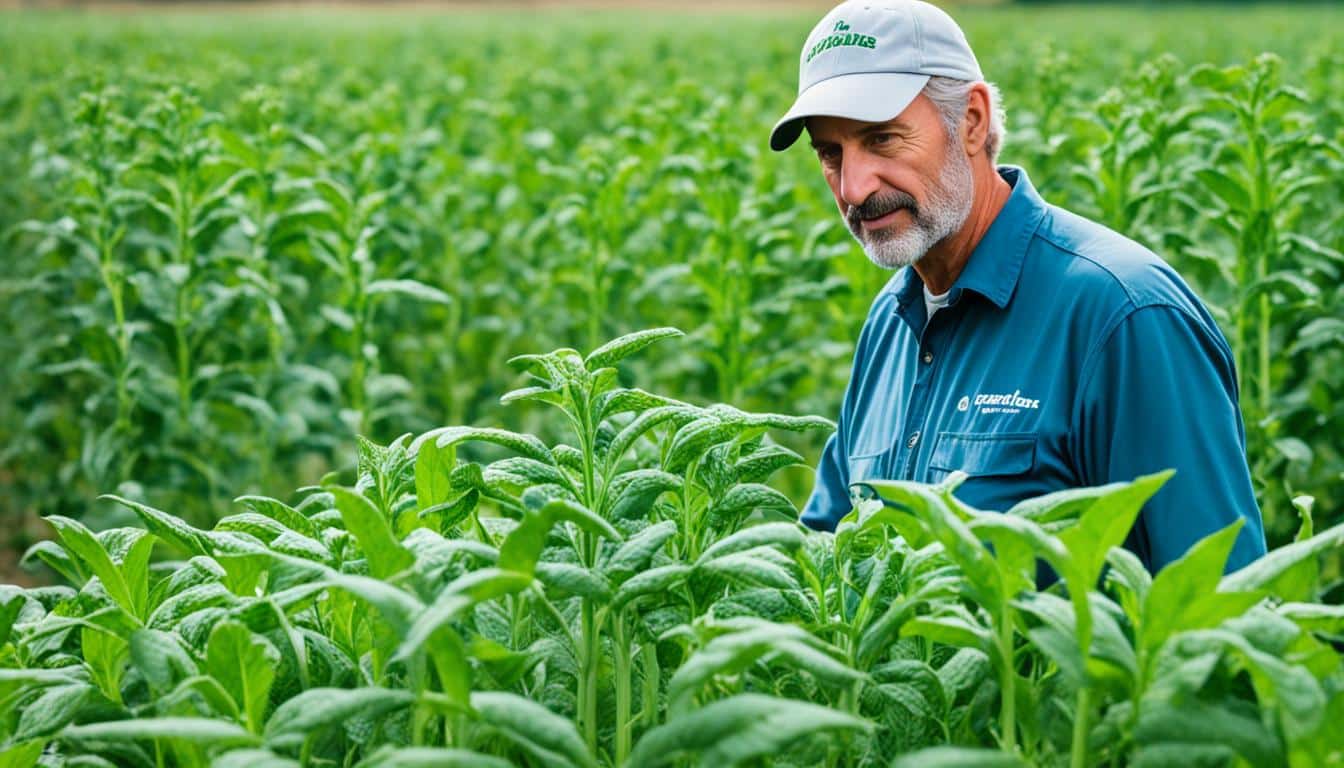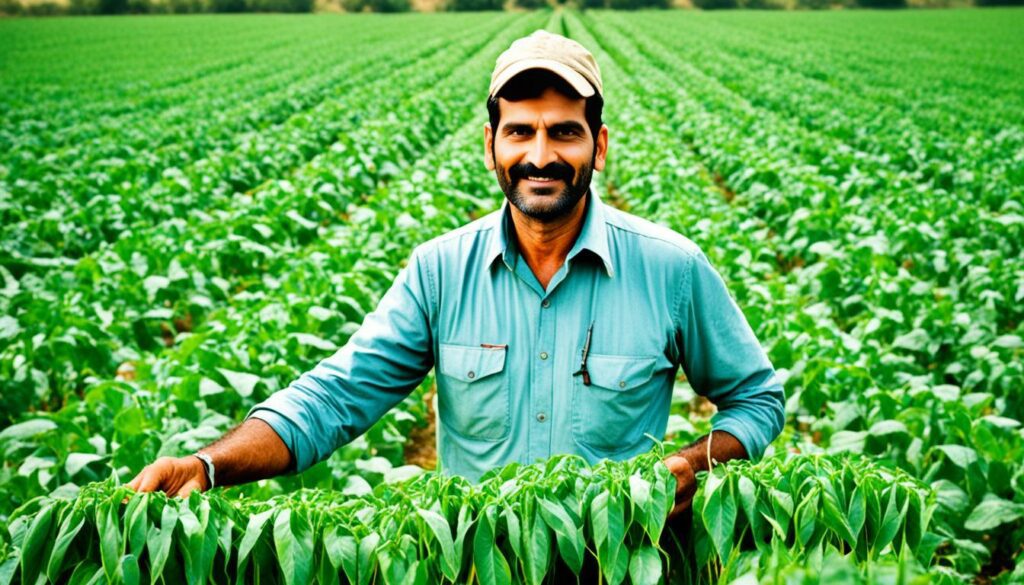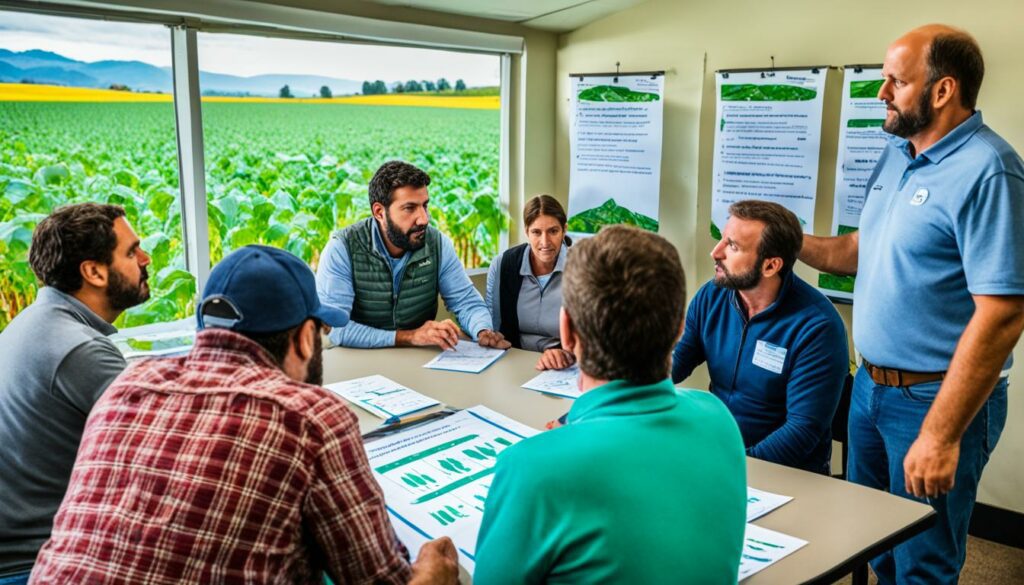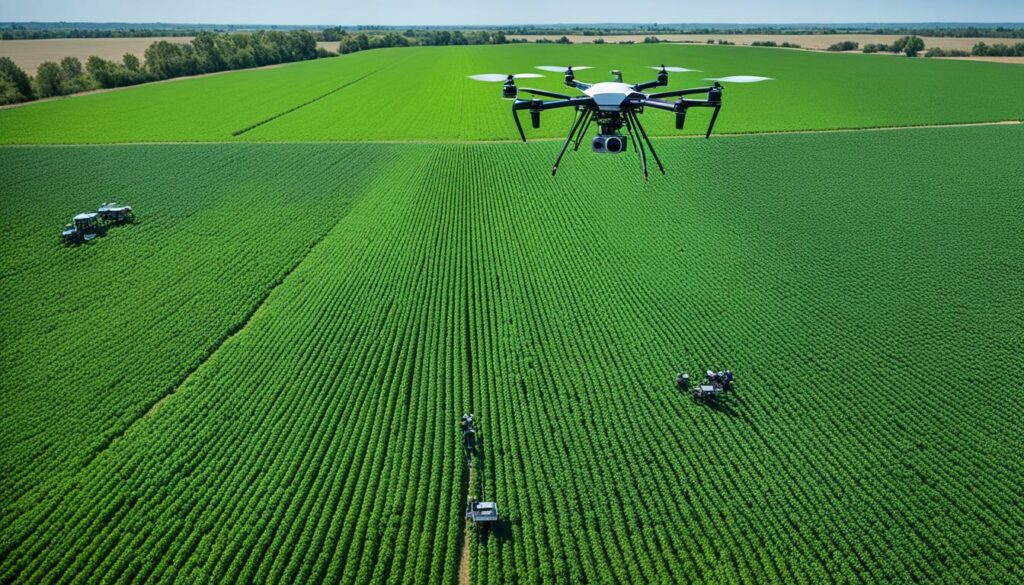Menu

Did you know India uses much less pesticide compared to Japan? It’s around 500 grams per hectare, while Japan uses 12 kilograms. But even with less use, India struggles to control pests. This happens because India has a lot of farmland growing crops like cotton and rice.
India has many people who depend on farming. To keep up with everyone’s needs, India has used a lot of chemical pest control over the last 40 years. However, this has caused harm to the environment and made pests get used to the chemicals. Now, India is looking at different ways to deal with pests. This includes Low External Input Sustainable Agriculture (LEISA) and farming without chemicals.
One key way Indian farmers are fighting pests is through Integrated Pest Management (IPM). IPM combines many ways to control pests, which are right for that area’s nature and the community. This method is good for the environment and aims to keep agriculture going without using harmful chemicals.
Integrated Pest Management (IPM) is a big change from old pest control ways. Now, we use methods that are good for the Earth and can last. It brings together many ways to fight pests without using lots of chemicals. Farmers keep their fields healthy and still grow a lot of food. They try not to harm nature around them.
Farmers who use IPM have lots of tools to fight pests. They use culture, nature, machines, and the right chemicals at the right time. With careful planning, they keep the bad bugs at bay without hurting the good bugs or the land. This way, pests don’t get used to the treatments and the fields stay balanced.
In India, farming uses much fewer pesticides than some other countries. But still, most are insecticides. IPM suggests using less of these and switching to friendlier options like Bt and neem. These are safe for the Earth and work well.
IPM makes farms better for the pocket and the planet. Rice farms practicing IPM spend less but earn more. They also realize how bad pesticides are for people’s health. So, they try to use fewer of them.
But IPM is about more than saving money and the environment. It’s also about keeping farms healthy for a long time. This makes it really important for today’s farmers facing big challenges.
The Green Revolution changed India’s farming scene with new high yielding crops. It brought on large farms growing the same crops, and lots of chemical use. But, this led to bugs getting used to the pesticides, like in Andhra Pradesh with the bollworm problem.

Near the late 1940s to the mid-1960s, times were tough for pest control in India. They only knew a little about pests and how to keep them away. The 1950s started showing them the harm from using too many chemicals, like harming nature and making pests stronger against the poisons.
Then, India began shifting to a mix of ways to fight pests, calling it integrated pest management (IPM). At first, it focused on farming naturally. But, as time went on, they also used friendly bugs and limited chemical stuff. By the 1990s, IPM was known worldwide.
In recent times, India has been all about better, greener ways to handle pests. It’s a top user of pesticides, but it’s working on new methods. Like using fewer chemicals and more nature-friendly ways. Yet, most of these efforts are seen in cotton and rice fields.
India puts a lot of effort into using helpful bugs against the bad ones. In just eight years, they spent a lot of money to do better on almost 4.3 million hectares. And they’ve made over 16,000 thousand bugs to help keep farms safe from pests.
Biopesticides such as Bacillus thuringiensis (Bt) and neem products are quite popular in India. In places like the Thanjavur Delta, farmers have seen good results. With IPM, farmers spent less but made more than those not using IPM. The result was a better life for both the farmers and the land.
Integrated Pest Management (IPM) starts with preventing pests, correctly identifying them, and using various ways to control them. This creates a good way to handle pests while keeping the environment and safety in mind.
IPM uses methods that stop pests by design. This includes things like changing crops each season, choosing plants that pests don’t like, and leaving the right amount of space between plants. By doing this, farmers can stop pest problems before they start, cutting down the need for reacting with harmful chemicals.
Keeping an eye on pests and knowing what they are is key to IPM. Checking fields often and using tools can find pests early. It’s really important to know the exact pest to pick the best way to control it. Studies show that most guides for handling pests focus a lot on figuring out what kinds of bugs they are.
IPM uses many ways to control pests, including natural, farming practices, and careful chemical use when needed. For example, letting out natural enemies of pests, like certain bugs, can help. So can keeping fields clean and managing crops well. Using chemicals comes last and is used carefully. About a quarter of guides recommend composting to make the soil better and help with pest control. They also talk about how community gardens can balance the local environment, making it harder for pests to cause big problems.
India is actively implementing Integrated Pest Management (IPM) through key initiatives such as Central Integrated Pest Management Centres (CIPMCs). These centres are vital for sharing knowledge and keeping an eye on pest diseases. They do this to ensure that IPM practices in India are effective. They use biocontrol agents to cut back on chemical pesticides, pointing farmers towards eco-friendly options.

The role of Farmers’ Field Schools (FFSs) is fundamental. They educate farmers on sustainable ways to manage pests. FFSs aim to raise awareness about pest management rules. They also push for the use of methods that are good for the environment. This helps unite local and broad agricultural pest control efforts.
There is a big push to use biocontrol agents more in Indian crops. Even though it’s still early, the Indian and Assam governments are supporting these efforts. They see the value in sustainable farming. Watching out for pests, using cultural methods to control them, and setting up traps are key parts of these efforts.
Studies show these moves are cutting down on dangerous chemicals. Articles in J. Exp. Biol. from 2011 and Science from 2001 point to this. They show that research in agro-ecology supports food security by using IPM smartly. While slow at first, the adoption of IPM is picking up. This is thanks to a joint effort to use fewer pesticides and expand sustainable farming.
To wrap up, IPM and biocontrol agents are changing how India deals with pests. Ongoing efforts to share pest management practices are making a difference. These include the work of FFSs. They are helping India move towards a balanced approach. This approach values both high crop yields and the well-being of our environment.
The use of Integrated Pest Management (IPM) has really helped Indian farming. Studies show, using IPM instead of old methods saves a lot of money and makes farming more profitable. In places like the Thanjavur Delta, IPM has cut costs for farmers and made them earn more money. This shows that IPM is a better choice for farmers than the ways used before.
When we compare the costs and benefits of IPM with old methods, IPM wins. One big reason is that IPM uses fewer harmful pesticides. These are often banned or not used much in richer countries. Yes, starting IPM might cost a bit more. But, in the long run, it saves farmers money by needing less chemicals and getting more crops. So, IPM really pays off by saving money and making farming better.
IPM not only helps farmers but also saves governments money. It reduces how much they have to spend on these bad chemicals. Pesticides can be a big problem, especially in poorer countries that don’t have strong rules about them. Choosing IPM over pesticides can help governments spend less on health and fixing environmental damage. Countries like the Philippines and Ecuador are finding that using IPM is better than using a lot of chemicals. This is important for their people and the planet.
IPM is good for everyone, not just for money. It means farmers grow food that’s safer to eat because it has less bad chemicals. Research shows that using IPM lowers the risk of getting sick from the food we eat. This is a win for both the farmers’ health and for people who buy their food. It also helps the environment. So, the benefits we get from IPM are not just about money. They’re about making sure farming is good for people, our health, and the Earth.
India has made progress in introducing Integrated Pest Management (IPM). However, IPM implementation barriers are still in place, slowing its adoption. The biggest hurdle is the widespread use of pesticides in farming. India consumes a huge amount of pesticides each year. Insecticides are used the most, making up 61% of the total.
Cotton farming uses a lot of pesticides, over 45%. These figures show how much India relies on chemical control.

One big farmer adoption challenge is the lack of knowledge about the harm pesticides cause. A survey done in the Thanjavur delta found that farmers using IPM knew more about these dangers.
Despite this, very few farmers use IPM, only 3.2%. Most, 93%, keep on using harmful chemicals. They get advice mainly from dealers and officials.
A major concern for farmers is the risk to their income by switching to IPM. But, data shows IPM farms actually make more money. Their costs are a bit higher but their profits are also higher.
Other difficulties are the lack of training and support, mentioned by 12.8% of respondents. Also, there are not enough supportive government policies, according to 9.4%. The Indian government has spent a lot on promoting biocontrol but it has not reached enough farmers yet.
The power of the pesticide industry is also a challenge. Studies show that more spending on IPM comes with higher pesticide use. Yet, farmers have trouble getting IPM materials and see them as expensive.
There are six main problems towards IPM: the need for more research and outreach, weaknesses in IPM itself, farmers’ uncertainty, the impact of the pesticide industry, and lacking incentives to adopt IPM. For instance, a good IPM method for pigeonpea has seen little use, even though it’s very effective.
| Challenge | Percentage of Responses |
|---|---|
| Insufficient training and technical support | 12.8% |
| Lack of favourable government policies | 9.4% |
| Farmer education and literacy levels | 7.5% |
| Difficulties in implementing IPM | 6.8% |
| Influence of the pesticide industry | 5.2% |
Overcoming these challenges requires teamwork and a focus on education, financial rewards, and strong policies. Together, these efforts can lead Indian farming to be more sustainable.
Pest management companies in India are key players. They help farmers in using better farming methods like Integrated Pest Management. Apart from controlling pests, they offer services to improve the lives of farmers.
These companies provide a wide range of services. They aim to reduce the use of harmful pesticides through:
Pest management companies do a lot to help farmers. They support them in using more eco-friendly methods. Their initiatives include:
These companies work closely with local governments to handle pest problems. In big farming states like Madhya Pradesh and Maharashtra, using IPM has been very successful. Farmers there use resources better and make more profit because of IPM.
| State | Pesticide Use (Metric Tons) | IPM Adoption Level |
|---|---|---|
| Madhya Pradesh | 5,230 | High |
| Maharashtra | 8,540 | Moderate |
| Uttar Pradesh | 7,210 | High |
| Andhra Pradesh | 9,120 | High |
| Karnataka | 6,980 | Moderate |
People are now more aware of the dangers of chemical pesticides. They are turning to organic pest control methods and eco-friendly pest management strategies. These options protect nature and keep us safe from harm.

Using chemical pesticides has hurt our air, water, and soil. It has also made people and animals sick with breathing issues and skin problems. This is a big problem for everyone’s health.
Integrated Pest Management (IPM) takes a broader view. It uses fewer harmful chemicals and more natural solutions. Things like vinegar, neem oil, and even lavender can keep pests away without hurting the environment.
The demand for organic pest control is growing fast. Products that use natural ingredients offer a green option. Good waste management is key too. It stops pests before they start, which means less need for harmful chemicals.
Here’s how non-chemical alternatives stack up against traditional methods:
| Aspect | Traditional Chemical Pest Control | Organic and Eco-Friendly Pest Control |
|---|---|---|
| Ingredients | Chemical-based | Natural and organic |
| Environmental Impact | Contaminates air, water, soil | Minimises ecological footprint |
| Health Risks | Respiratory problems, skin irritations | Little to no health hazards |
| Effectiveness | Short-term, often causes resistance | Long-term, promotes sustainable pest control |
| Cost | May be cheaper initially | Cost-effective in the long run |
Professional pest control services are changing too. They now offer methods that are safe for the environment and for us. These experts ensure pest problems are handled in a way that’s good for the planet.
Choosing organic pest control and eco-friendly ways is important for a better future. It keeps our world healthy for the generations to come.
Integrated pest management (IPM) has boosted eco-friendly crop growing in different fields. This part takes a look at three successful IPM case studies. They show the big changes IPM brought to growing rice, cotton, and vegetables.
In Indonesia, rice farming is a leading light for using IPM well. Rice takes up about 60% of all farmed land there. Since 1984, it’s been self-sufficient in rice. IPM helped cut back on chemical sprays. This step made growing rice safer for the environment. Also, from 2007, the amount of pesticides used dropped a lot. It went from 2.6 billion kg to 1.7 billion kg. This showed how IPM could keep the land and the rice crops healthy.
In India’s Ashta village, IPM made a big difference in cotton fields. Before 2002, the farms used lots of chemical sprays on cotton, about 54% of the total. But, after starting IPM, cotton yields got a boost, up to 77.1%! The area managed to grow 962.5 kg of seed cotton from every hectare. This success story matched India’s wish to use fewer pesticides and farm more sustainably.
The United States has seen big wins with IPM in vegetable growing. Every year, farmers save about $500 million because IPM costs less. Now, 86% of the veggies grown there come from IPM farms. This shows just how much IPM can help. It raises crop amounts and quality without harming the earth. This proves IPM can change farming for the better, bringing big social and environmental gains.
Integrated Pest Management (IPM) is crucial for sustainable farming. It combines different pest control ways that are good for the planet and people. By using natural pest repellents and biological agents in farming, we find greener solutions. This is especially useful for farmers in India.

In India, using helpful organisms for pest control is big. Creatures like ladybirds, Trichogramma spp., and Bacillus thuringiensis are important for this. They help keep pest numbers low without using many chemicals. This approach keeps farms healthy and the environment balanced.
Effective pest monitoring is key in Integrated Pest Management (IPM) in India. It uses pest monitoring methods and field survey techniques. These help us find and name the pests correctly. This is very important in managing pests well.
Field surveys are vital to know about pests in farms. They help in getting data systematically. This assists farmers and experts in spotting and controlling pest attacks. In India, pests hit goods like cotton and rice hard, so keeping a close eye is a must. Over half of all pesticides there are used to fight pests.
Using high-tech tools in IPM has changed how we watch for pests. Things like remote sensing, drones, and special software give us detailed information fast. This means we can act quickly and accurately. In India alone, 47,020 metric tons of pesticides are used yearly. So, finding eco-friendly ways to handle pests is a must.
| IPM Aspect | Conventional Practices | Advanced IPM Techniques |
|---|---|---|
| Insecticides Usage | 61% of total pesticide consumption | Reduced through biocontrol agents |
| Crop Focus | Cotton (45% pesticide use), Rice (22%) | All crops with tailored IPM strategies |
| Technology Incorporation | Minimal | High with drones, remote sensing |
The Indian government backs up pest monitoring, spending about Rs. 59 million on the task. A key point to note is that states using more IPM also use more synthetic chemicals. This shows a complex link between pest monitoring methods and chemical use. The move to include more agricultural technology in IPM points to a bigger aim: using methods that are good for the environment.
The role of training and capacity building in Integrated Pest Management (IPM) is huge. Many efforts are being made to teach professionals how to use IPM effectively and for a long time.

Farmers’ Field Schools are key in building skills in farming. These schools give farmers real-world knowledge they can apply. Farmers learn to identify pests, assess the risks, and use certain treatments to manage these pests.
Workshops and seminars are important for educating and improving the skills of farmers. The National Institute of Plant Health Management (NIPHM) has led in organising these events since 1966. It has become independent since 2008. For example, it has conducted training since 2018, with two ITEC courses, educating 42 people on pest detection, fumigation, and seed health testing. These sessions greatly help in building agricultural capacity.
| ITEC Courses | Participants | Focus Areas |
|---|---|---|
| 2 | 42 | Pest Detection, Pest Risk Analysis |
| Detection and Diagnosis Training (November 2018) | 27 Uzbekistan Officials | Fumigation, Molecular Detection |
The NIPHM focuses its training on both public and private groups to spread knowledge widely. Its training covers topics like Integrated Pest Management, Pesticide Management, and Plant Quarantine. With these training sessions, plus field schools for farmers and others, they’re more ready to handle pest issues sustainably.
Integrated Pest Management (IPM) brings big ecological benefits and health advantages to farming. It uses many methods to control pests. So, farms use less man-made pesticides. This makes the land, water, and air cleaner and safer for all.
IPM helps reduce the amount of pest-killers left on food. This means less risk to the health of those eating the food and the workers who farm it. By being proactive, IPM also helps lower pollution. It protects other animals, keeping nature in balance.
For the environment, IPM is a friend to the good bugs and animals that eat pests. This helps keep farming stable and full of life. IPM fits well in different places and makes farming more efficient. This way, we get more crops without harming nature.
Reducing pesticides on the farm is really important. Let’s look at some facts:
| Impact | Conventional Methods | IPM Methods |
|---|---|---|
| Pesticide Residues | High | Low |
| Non-Target Species Affected | Many | Few |
| Health Risks for Workers | Significant | Minimal |
| Biodiversity | Decreased | Increased |
IPM is not just good for nature. It’s also about keeping farms healthy for the long run. By using IPM, we don’t rely too much on just one way to kill pests. This helps keep the pest killers strong and useful. Overall, IPM is key to farming that is both sustainable and safe for everyone.
The future of Integrated Pest Management (IPM) in India looks very bright. This is thanks to ongoing advances in IPM and changes in India’s farming policies. There’s a strong focus on finding ways to control pests that are both effective and good for the environment.

Improvements in technology are key in making IPM better. Digital farming and high-tech tools give us new ways to watch and deal with pests. Smart sensors and drones help us spot pest problems quickly. This lets us use treatments that are right on target.
What’s really exciting is the work on biopesticides and crops that fight off pests by themselves. These ideas could change the way we handle pests. It could mean more crops grown with less harm to our planet.
Having strong support from laws and leaders is vital for future IPM success. We need our leaders to focus on finding cheap, eco-friendly ways to manage pests. They should make it easy for farmers to try out new pest controls. This includes encouraging the use of natural pest fighters and greener farming methods.
| Country | Per Capita Pesticide Consumption (kg/ha) | Productivity (tons/ha) |
|---|---|---|
| India | 0.6 | 4 |
| China | 13 | 10.5 |
| USA | 4.5 | 7 |
To make IPM better, we could offer help and learning to farmers. This help could be in the form of money or knowledge about better pest management. Also, working with companies that know a lot about this could really help. Together, these efforts would make sure we have enough safe food and keep our environment healthy. India would then lead the way in farming that cares for our earth.
India is working hard to control pests sustainably with Integrated Pest Management (IPM). In one year, the country’s agrochemical industry made a huge 47,020 metric tons of pesticides. Insecticides were the top type used, making up 61% of the total, then came fungicides (19%) and herbicides (17%). Yet, India uses only about 500 grams of pesticides per hectare. This is way less than countries like Japan (12 kg) and Germany (3 kg).
Most of these pesticides, 45%, were used on cotton, and 22% on rice. This shows that certain crops rely heavily on chemical controls. But, there is positive change happening with IPM. For eight years, the Indian government spent Rs. 14,926 million to control pests with natural means, and another Rs. 59 million on monitoring pests. This shows a planned effort to manage pests better.
The use of natural pest controls like Bacillus thuringiensis (Bt) and neem insecticides has done better than expected. These methods helped manage pests on 523,000 hectares, doing 42.51% better than the goal. An analysis from Tamil Nadu’s Thanjavur Delta showed that farms using IPM got a better profit. Their Benefit Cost Ratio was 1.62, while it was lower, 1.43, for farms not using IPM. This proves that IPM is not only good for the environment but also for farmers’ incomes.
Thanks to education, policy help, and new technology, IPM is becoming a key part of pest control. As India improves its IPM methods, it’s looking to use greener methods in farming. This will help Indian agriculture stay strong in the face of pest problems while protecting its diverse wildlife.
Integrated Pest Management (IPM) is a green method to control pests. It uses many ways to keep pests in check. This approach is kinder to the earth, cutting down on harmful pesticides. It also promotes natural farming and helps farmers save money.
IPM focuses on stopping pests before they become a big problem. It keeps a close eye on the types of pests and the damage they’re doing. Then, it uses different ways to manage them specifically. The goal is to control pests without causing much harm to others or the environment.
In India, pest management changed a lot with the Green Revolution. This was when new crops were introduced that produced more food. But, it also started more farming of the same crop and heavy use of pesticides. This led to problems with the environment and pests that became resistant to the pesticides. So, the focus moved to methods like IPM that are better for the long term.
IPM helps farms save money by reducing the need for expensive pesticides. It is also shown to increase profits and work more efficiently. For example, a study in Thanjavur Delta found that using IPM can be more profitable than the traditional ways.
Making IPM work in India is not easy. Many farmers are used to the old, pesticide-heavy ways. They may not know the dangers of these chemicals. Plus, switching to IPM can feel risky because it’s a big change and might cost more initially.
Companies that deal with pest control are key in helping farmers move to IPM. They offer advice, training, and the bugs that eat the bad bugs. This support makes it easier for farmers to use IPM effectively.
Organic ways, using things like natural pesticides and special farming techniques, are important in IPM. They look after the environment, reduce the chemicals used, and help keep pests in control in a safe way.
There are many success stories in India with IPM. Places growing rice, cotton, and vegetables have seen better harvests and used fewer pesticides. This means they’re spending less money and the farm is healthier.
Natural pest repellents, like neem and helpful bugs, are central in IPM. They offer simple, low-cost ways to deal with pests. These methods line up well with looking after the land for the future.
In IPM, checking for pests happens through careful field checks and high-tech ways. This makes sure any problem is found quickly and managed in time.
Teaching farmers about IPM is crucial for it to spread. Workshops and lessons educate them on the best IPM ways. This helps build a skilled group of farmers who know how to manage pests well.
IPM is great for nature and people’s health. It cuts down on pollution and harmful chemicals. At the same time, it protects animals and keeps farmers safe. This makes it an all-around good way to deal with pests.
The future looks bright for IPM in India, thanks to new technology and policies. More research and the development of natural pesticides will make IPM even more successful. This will help it be used more widely across the country.